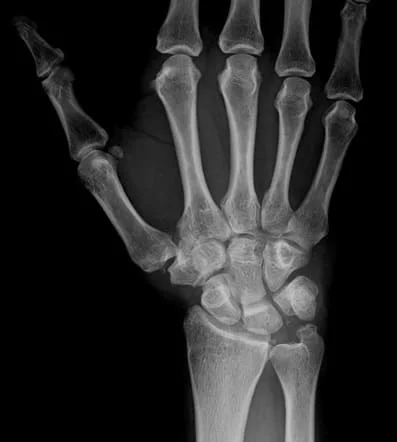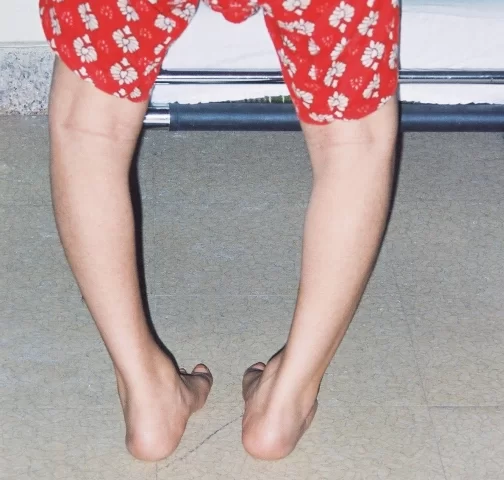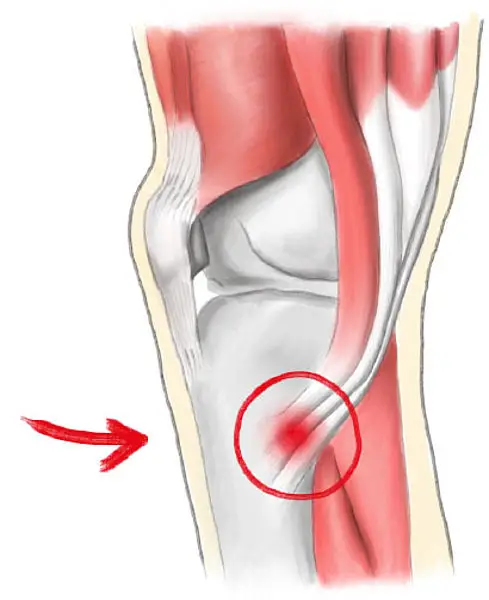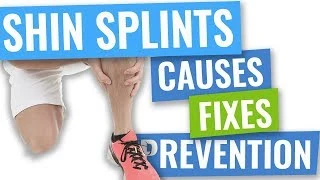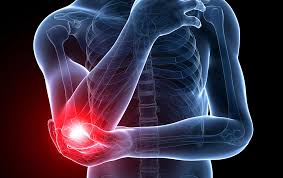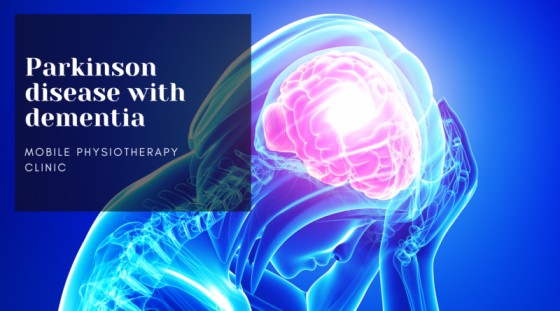Ulnar Styloid Impaction Syndrome
Definition
Ulnar styloid impaction syndrome, also known as ulnar impaction syndrome or ulnar abutment syndrome, is a medical condition that affects the wrist. It occurs when the ulnar styloid process, a bony prominence located on the outer side of the wrist, becomes compressed and abuts against the triangular fibrocartilage complex (TFCC) or the ulnar head. The TFCC is a cartilage and ligament structure that stabilizes the wrist joint.
The ulnar styloid impaction syndrome often develops in individuals who have a longer ulna (the forearm bone on the pinky side) or a shorter radius (the forearm bone on the thumb side). This anatomical discrepancy can cause the ulnar styloid process to impact the TFCC during certain wrist movements, leading to irritation, inflammation, and eventually degenerative changes.
Some common causes of ulnar styloid impaction syndrome include:
Ulnar variance: Variance in the length of the ulna compared to the radius can create abnormal stress on the ulnar side of the wrist.
Repetitive stress: Activities that involve repetitive or forceful wrist movements can contribute to the development of this condition, especially in athletes or individuals with certain occupations.
Previous wrist injuries: A history of wrist trauma, such as fractures or sprains, may increase the risk of ulnar styloid impaction syndrome.
Instability of the wrist joint: Any condition that leads to wrist joint instability can exacerbate the impaction of the ulnar styloid process.
Previous Wrist Injuries: A history of wrist trauma, such as fractures, sprains, or other injuries, can lead to changes in the alignment of the wrist bones. These altered mechanics may increase the likelihood of the ulnar styloid process impinging on the TFCC.
Repetitive Wrist Movements: Activities that involve repetitive or forceful wrist movements can contribute to the development of ulnar styloid impaction syndrome. These activities may cause increased friction and pressure on the TFCC and ulnar styloid process, leading to inflammation and impingement.
Wrist Joint Instability: Any condition that causes instability in the wrist joint can exacerbate ulnar styloid impaction. Conditions such as ligament injuries or certain types of arthritis can disrupt the normal alignment of the wrist bones, increasing the risk of impingement.
Congenital Factors: In some cases, ulnar styloid impaction syndrome may be present from birth due to congenital anomalies or variations in the structure of the wrist bones.
Overuse or Occupational Factors: Certain occupations or activities that place excessive stress on the wrist joint may contribute to the development of this condition. Examples include athletes who engage in repetitive wrist movements or individuals with jobs that require frequent use of the wrist, such as manual laborers.
It’s essential to note that the development of ulnar styloid impaction syndrome is often a multifactorial process, and several of the above factors may be present in an individual who experiences wrist pain and impingement. Proper diagnosis and treatment by a healthcare professional are crucial to manage the condition effectively and prevent further complications.
Symptoms of ulnar styloid impaction syndrome might include:
Ulnar styloid impaction syndrome can cause a variety of symptoms, which typically manifest on the ulnar side of the wrist (the side of the little finger). The severity of symptoms can vary depending on the extent of impingement and inflammation. Common symptoms of ulnar styloid impaction syndrome include:
Pain: Pain is the most prevalent symptom and is usually localized to the ulnar side of the wrist. The pain may be dull, aching, or sharp and is often aggravated by wrist movements, especially during ulnar deviation (bending the wrist towards the little finger side).
Tenderness: The area around the ulnar styloid process may be tender to the touch.
Swelling: Inflammation can lead to swelling over the ulnar styloid area.
Clicking or Popping Sensations: During certain wrist movements, you may experience clicking, popping, or snapping sensations in the affected wrist.
Limited Range of Motion: Impingement of the ulnar styloid process can restrict the wrist’s range of motion, particularly during ulnar deviation and other movements that involve the ulnar side of the wrist.
Weakness: Some individuals with ulnar styloid impaction syndrome may experience weakness in the hand and reduced grip strength.
Difficulty with Weight-Bearing Activities: Activities that involve bearing weight on the affected wrist, such as push-ups or weightlifting exercises, may exacerbate the symptoms.
Wrist Instability: In some cases, the impaction of the ulnar styloid process can contribute to wrist joint instability, leading to further discomfort and difficulty in performing daily tasks.
Complications of Ulnar Styloid Impaction Syndrome:
Carpal Tunnel Syndrome: The impaction of the ulnar styloid can contribute to increased pressure within the carpal tunnel, potentially causing symptoms like pain, numbness, and weakness in the hand and fingers.
Ganglion Cysts: Continuous irritation from the impinged ulnar styloid can lead to the development of ganglion cysts, fluid-filled lumps that may form near the affected area.
Arthritis: Chronic inflammation and instability in the wrist joint can contribute to the development of arthritis, leading to joint pain, stiffness, and reduced function.
Tendonitis: The repetitive friction between the ulnar styloid and adjacent tendons can result in inflammation and tendonitis, causing discomfort and limiting wrist movement.
Wrist Instability: Impaction of the ulnar styloid can contribute to wrist instability, increasing the risk of sprains, dislocations, or other traumatic injuries.
Reduced Grip Strength: Over time, the impingement can affect the function of muscles and tendons in the wrist and hand, leading to reduced grip strength and difficulties in performing everyday tasks.
Limited Range of Motion: If left untreated, ulnar styloid impaction syndrome can progressively restrict the range of motion in the wrist, making it challenging to perform activities that require wrist flexibility
Diagnosis
The diagnosis of ulnar styloid impaction syndrome involves a comprehensive evaluation by a healthcare professional, typically an orthopedic surgeon or a hand specialist. The process of diagnosis usually includes the following steps:
Medical History: The doctor will begin by taking a detailed medical history, including any previous wrist injuries, occupational or sports activities involving repetitive wrist movements, and the nature and duration of your symptoms.
Physical Examination: A thorough physical examination of the affected wrist will be conducted to assess for signs of tenderness, swelling, range of motion, and stability. The doctor will also perform specific tests to elicit symptoms and check for clicking or popping sensations during wrist movements.
Imaging Studies: X-rays of the wrist are often the first imaging modality used to evaluate the bony structures. X-rays can help identify any structural abnormalities, such as ulnar variance or previous wrist injuries, which may contribute to ulnar styloid impaction syndrome. In some cases, additional imaging studies like MRI or CT scans may be ordered to assess soft tissues and provide more detailed information about the TFCC and surrounding structures.
Diagnostic Injections: In some situations, the doctor may perform diagnostic injections of local anesthetics around the ulnar styloid process or the TFCC. If the pain significantly improves after the injection, it suggests that the impingement is the likely cause of the symptoms.
Electrodiagnostic Studies (EMG/NCS): In certain cases where nerve compression or entrapment is suspected, electrodiagnostic studies may be performed to evaluate nerve function and assess for any nerve-related issues.
Arthroscopy (In Some Cases): In more complex or challenging cases, the doctor may recommend an arthroscopic examination of the wrist joint. During arthroscopy, a thin, flexible camera (arthroscope) is inserted through small incisions, allowing direct visualization of the wrist joint’s internal structures.
After a thorough evaluation and the completion of all necessary diagnostic tests, the healthcare professional will make a definitive diagnosis of ulnar styloid impaction syndrome. It’s important to remember that the diagnosis may require ruling out other possible causes of wrist pain and dysfunction, as similar symptoms can be seen in other wrist conditions.
Differntial Diagnosis
The symptoms of ulnar styloid impaction syndrome can sometimes overlap with those of other wrist conditions. A differential diagnosis is essential to distinguish ulnar styloid impaction syndrome from other potential causes of wrist pain and dysfunction. Many of the conditions that might be considered in the differential diagnosis include:
Triangular Fibrocartilage Complex (TFCC) Injuries: TFCC tears or injuries can cause pain on the ulnar side of the wrist, similar to ulnar styloid impaction syndrome. TFCC injuries can result from trauma or degenerative changes and may require specific imaging, such as MRI or arthroscopy, to confirm the diagnosis.
Ulnar Collateral Ligament (UCL) Injury: Injuries to the UCL can cause pain and instability on the ulnar side of the wrist. UCL injuries are more common in athletes who engage in repetitive wrist motions, such as baseball players.
Wrist Osteoarthritis: Osteoarthritis can affect the wrist joint and cause pain, stiffness, and limited range of motion. It may be challenging to differentiate osteoarthritis from ulnar styloid impaction syndrome based solely on symptoms, and imaging studies may be necessary for an accurate diagnosis.
Kienböck’s Disease: This condition involves avascular necrosis of one of the small bones in the wrist (lunate bone). It can cause pain, stiffness, and weakness, particularly on the ulnar side of the wrist.
Wrist Fractures: Previous wrist fractures, especially those involving the ulnar styloid process or the distal radius, can lead to ongoing pain and functional limitations.
Carpal Tunnel Syndrome (CTS): While CTS primarily affects the median nerve and causes symptoms in the thumb, index, and middle fingers, it can sometimes cause secondary pain or symptoms in the ulnar side of the wrist.
De Quervain’s Tenosynovitis: This condition involves inflammation of the tendons on the thumb side of the wrist and can sometimes cause referred pain on the ulnar side.
Ganglion Cysts: These fluid-filled cysts can develop near the wrist joint and cause pain or discomfort.
Wrist Tendonitis: Inflammation of tendons in the wrist can lead to localized pain, which might be mistaken for ulnar styloid impaction syndrome.
Wrist Instability: General wrist joint instability, caused by ligament injuries or other factors, can lead to pain and dysfunction on the ulnar side.
Medical Treatment
The goals of treatment for ulnar styloid impaction syndrome are to relieve discomfort, lessen swelling, and enhance wrist function. The choice of treatment depends on the severity of symptoms, the underlying cause, and the individual’s specific needs. The following are some common medical treatments for ulnar styloid impaction syndrome:
Rest and Activity Modification: Avoiding activities that exacerbate symptoms can help reduce stress on the wrist and promote healing. Temporary immobilization with a brace or splint may be recommended to rest the wrist and protect it from further injury.
Nonsteroidal Anti-Inflammatory Drugs (NSAIDs): Over-the-counter NSAIDs, known as ibuprofen or naproxen, can help reduce pain and inflammation. Moreover, it’s crucial to use them under the guidance of healthcare doctors and follow the recommended dosage.
Corticosteroid Injections: If conservative measures are not providing sufficient relief, corticosteroid injections may be administered directly into the affected area to reduce inflammation and alleviate pain. However, repeated steroid injections should be used judiciously due to potential side effects.
Physical Therapy: A physical therapist can design a customized exercise program to improve wrist strength, flexibility, and stability. This may involve stretching, strengthening exercises, and proprioceptive training to enhance wrist control and reduce symptoms.
Ultrasound Therapy: Ultrasound therapy may be used to promote healing, reduce inflammation, and alleviate pain in the affected area.
Occupational Therapy: An occupational therapist can teach ergonomic techniques and advise on modifying daily activities to minimize stress on the wrist.
Wrist Brace or Splint: A wrist brace or splint may be prescribed to provide support and restrict movement during activities that worsen symptoms. This can help protect the wrist from further impingement and promote healing.
Extracorporeal Shock Wave Therapy (ESWT): In some cases, ESWT may be used to deliver high-energy shock waves to the affected area, which can help stimulate healing and reduce pain.
Prolotherapy or Platelet-Rich Plasma (PRP) Injections: These regenerative treatments involve injecting a solution or platelet-rich plasma into the affected area to promote tissue repair and reduce inflammation.
If conservative medical treatments do not provide sufficient relief, or if the condition is caused by significant structural abnormalities, surgical intervention may be considered. Surgery aims to address the underlying anatomical issues, such as correcting ulnar variance or repairing TFCC tears, to alleviate the impingement.
The choice of medical treatment should be made in consultation with a healthcare professional who can tailor the approach based on individual factors and the specific characteristics of the ulnar styloid impaction syndrome. Early intervention and proper management can often lead to successful outcomes and improved wrist function.
Physiotherapy Treatment
Physiotherapy plays a crucial role in the conservative management of ulnar styloid impaction syndrome. A skilled physiotherapist can design a comprehensive treatment plan to reduce pain, improve wrist function, and prevent further complications. The physiotherapy treatment for ulnar styloid impaction syndrome may include the following:
Pain Management: Physiotherapists may use various modalities, such as ice or heat therapy, ultrasound, or transcutaneous electrical nerve stimulation (TENS), to help manage pain and reduce inflammation in the affected wrist.
Manual Therapy: Hands-on techniques, such as soft tissue mobilization, joint mobilization, and myofascial release, may be employed to improve wrist joint mobility, release muscle tension, and reduce stiffness.
Stretching Exercises: Specific stretches for the wrist and forearm muscles can help improve flexibility and reduce strain on the affected area. Gentle and controlled stretching should be performed to avoid exacerbating symptoms.
Strengthening Exercises: Strengthening the muscles around the wrist and forearm can provide stability and support to the joint, helping to alleviate pressure on the ulnar styloid process. Exercise can target the wrist flexors, extensors, and other forearm muscles.
Proprioceptive Training: Proprioception refers to the body’s sense of joint position and movement. Proprioceptive exercises can help improve wrist control and stability, reducing the risk of impingement during various activities.
Activity Modification: The physiotherapist will provide guidance on modifying daily activities and sports to prevent excessive stress on the wrist. This may involve ergonomic adjustments and teaching proper wrist mechanics during specific movements.
Bracing or Taping: The use of a wrist brace or taping techniques may be recommended to provide external support, restrict excessive movement, and reduce impingement during activities that aggravate symptoms.
Gradual Return to Activities: Physiotherapists will guide the individual in gradually returning to sports or activities after symptom improvement, ensuring that the wrist is adequately prepared for increased demands.
Education and Self-Management: Educating the patient about the condition, proper wrist care, and injury prevention strategies are essential for long-term management. Physiotherapists can also teach self-management techniques, such as home exercises and methods for pain relief.
Postural Assessment and Correction: Poor posture can contribute to wrist issues. The physiotherapist will assess and address any postural factors that might be impacting the wrist.
Exercise For Ulnar Styloid Impaction Syndrome
Wrist Flexor Stretch: Extend the patient’s affected arm straight in front of his with your palm facing upside.
Use your other hand to gently bend your wrist back, stretching the muscles on the palm side of the forearm.
Hold the stretching for about twenty to thirty seconds, then release.
Repeat the stretching three to five times, two to three times a day.
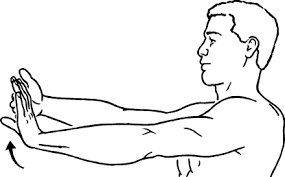
Wrist Extensor Stretch: Extend the patient’s affected arm straight in front of you with the patient’s palm facing down.
Use your other hand to gently bend your wrist down, stretching the muscles on the back of the forearm.
Hold the stretching for about twenty to thirty seconds, then release.
Repeat the stretching three to five times, two to three times a day.
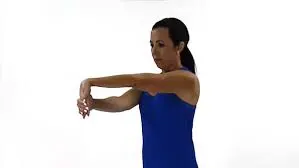
Wrist Pronation and Supination: Sit or stand with your affected forearm resting on a table or your thigh.
Hold a light dumbbell or a small weight in the patient’s hand, palm facing down.
Slowly rotate your wrist to bring your palm up (supination) and then back down (pronation).
Perform 2-3 sets of 10-15 repetitions, 2-3 times a day.
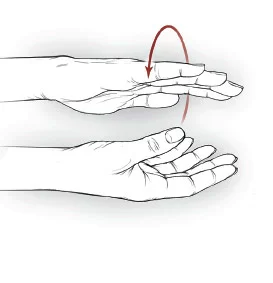
Grip Strengthening Exercise: Squeeze a softball or stress ball in your affected hand, holding the squeeze for a few seconds.
Relax and repeat the squeezing motion for 10-15 repetitions.
Perform 2-3 sets, 2-3 times a day.
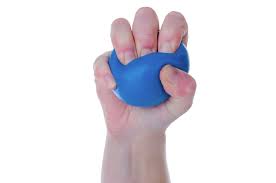
Finger Tapping: Place your affected hand flat on a table or a firm surface.
Lift each finger, one at a time, tapping it on the surface while keeping the other fingers down.
Perform 10-15 taps for each finger, repeating for 2-3 sets.
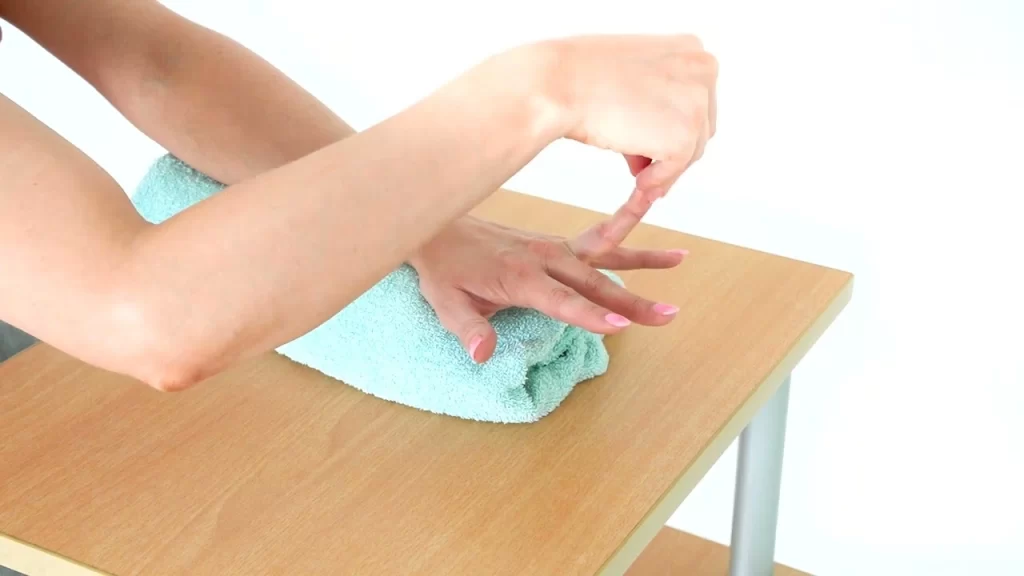
Wrist Circles: Hold your affected arm out with your elbow straight and your palm facing down.
Make small circular motions with your wrist, gradually increasing the size of the circles.
Perform 10 circles in one direction and then 10 circles in the opposite direction.
Repeat 2-3 times a day.

Remember to perform these exercises slowly and with control, avoiding any movements that cause pain or discomfort. If you experience increased pain or worsening of symptoms during exercises, stop the activity and consult with your healthcare professional or physiotherapist. A well-designed exercise program, along with appropriate rest and activity modification, can help manage ulnar styloid impaction syndrome and improve wrist function over time.
Surgical Treatment
Surgical treatment for ulnar styloid impaction syndrome is typically considered when conservative measures have not provided sufficient relief or if the condition is caused by significant structural abnormalities that cannot be effectively addressed non-surgically. The surgical procedures aim to alleviate pressure on the ulnar styloid process and the triangular fibrocartilage complex (TFCC) and may involve the following options:
Ulnar Shortening Osteotomy: In cases of ulnar positive variance, where the ulna is longer than the radius, an ulnar shortening osteotomy may be performed. During this procedure, a portion of the ulna bone is removed or repositioned to reduce the length difference between the ulna and the radius. This helps to normalize the forces within the wrist joint and prevent impingement.
TFCC Repair or Debridement: If the ulnar styloid impaction syndrome is associated with TFCC tears or injuries, the surgeon may perform a repair or debridement of the damaged TFCC. This procedure aims to restore stability to the wrist joint and reduce pain.
Arthroscopic TFCC Debridement: Using arthroscopic techniques, the surgeon can remove damaged or inflamed tissue within the TFCC, helping to alleviate impingement and promote healing.
Ulnar Head Resection: In some instances, the surgeon may choose to remove a portion of the ulnar head to create more space in the wrist joint and reduce impingement.
Wrist Fusion (Arthrodesis): In severe cases of ulnar styloid impaction syndrome with advanced arthritis or instability, a wrist fusion may be considered. During this procedure, the carpal bones and the radius are fused together to eliminate movement in the wrist joint, reducing pain and preventing further impingement.
Wrist Denervation: This procedure involves cutting the sensory nerves in the wrist joint to reduce pain signals. It is usually considered in cases of chronic pain when other surgical options are not suitable
FAQ
What happens if ulnar impaction syndrome is not untreated?
If untreated, this condition could create other problems including arthritis, prolonged disability, and damage to other wrist structures
How much time to take recover time for ulnar impaction syndrome surgery?
You would be instructed to NOT use the patient hand for any work or self-care tasks for about 6-8 weeks depending on the type of work the patient is returning to. Too much activity too soon might alter the placement of the hardware or might cause a non-union of the ulna bone
How does a person can prevent ulnar impaction syndrome?
Conservative treatment shall be attempted before surgery and could include immobilization for six to twelve weeks, NSAIDs, corticosteroid injection, and limiting the aggravating range of motion known as gripping pronation, and ulnar deviation. Lack of improvement with conservative management is an indication of surgery

